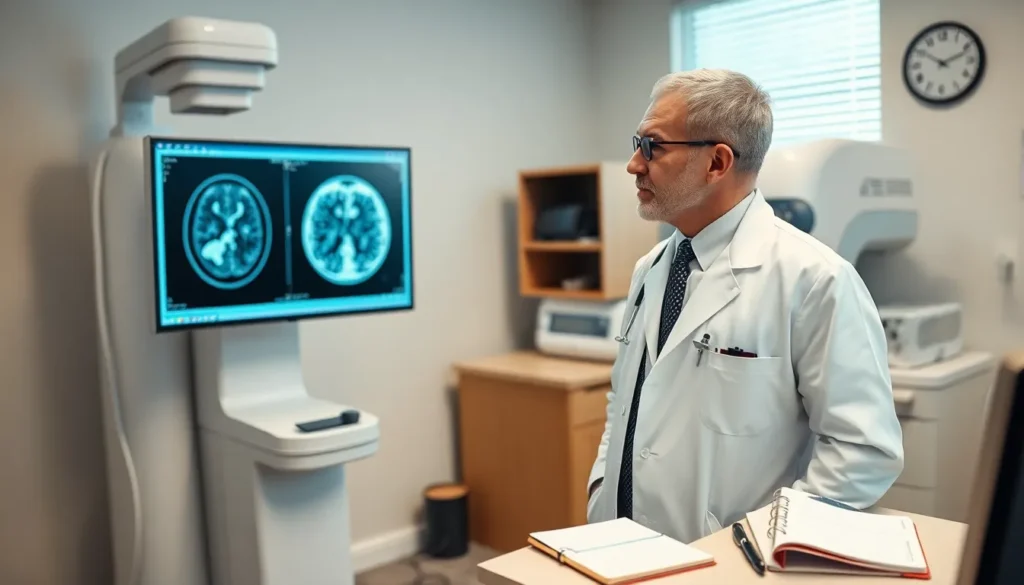Table of Contents
ToggleSudenzlase might sound like a character from a quirky sci-fi movie, but it’s a real condition that demands serious attention. Diagnosing it can feel like a treasure hunt—one filled with tests, evaluations, and a sprinkle of mystery. If you’ve ever wondered how medical professionals unravel the complexities of this condition, you’re in for a treat.
From initial consultations to advanced imaging techniques, the journey to a diagnosis is anything but dull. With each step, doctors piece together clues like detectives on a mission. So buckle up as we dive into the fascinating world of sudenzlase diagnosis, where science meets curiosity and a dash of humor. You might just find yourself laughing while learning how experts crack the code behind this elusive condition.
Understanding Sudenzlase
Sudenzlase presents unique challenges for medical professionals. This condition often requires a multi-faceted approach to accurately identify its presence. Initially, healthcare providers conduct thorough patient interviews, gathering detailed medical histories that may reveal risk factors or symptom patterns. After this, physical examinations are essential to assess any visible signs related to sudenzlase.
Diagnostic imaging plays a crucial role in confirming suspicions. Techniques such as MRI or CT scans are commonly employed to visualize abnormalities linked to sudenzlase. These imaging tests help reveal structural changes in the body, aiding in the diagnostic process.
Laboratory tests also contribute significantly to understanding sudenzlase. Blood work may be ordered to check for markers that indicate inflammation or other related issues. Additionally, specialty tests might be necessary for specific symptoms that arise, aligning with the overall clinical picture.
After collecting results from hands-on evaluations, imaging, and laboratory tests, healthcare providers synthesize the information. They analyze findings to formulate a clear diagnosis. Collaboration among specialists enhances the accuracy of the diagnosis; neurologists, radiologists, and primary care physicians often work together to arrive at a consensus.
Diagnosis of sudenzlase is not solely dependent on one singular method. A comprehensive approach ensures that no aspect of the patient’s health is overlooked. As a result, effective management and treatment strategies can be developed, addressing the unique needs of each individual.
Symptoms of Sudenzlase

Sudenzlase presents a range of symptoms that vary in presentation and severity among patients. Recognizing these symptoms aids in timely diagnosis.
Common Symptoms
Patients often report headaches characterized by a throbbing or persistent sensation. Fatigue frequently accompanies the condition, affecting daily activities. Stomach issues, including nausea and indigestion, also occur significantly. Mood changes, like anxiety or irritability, might emerge as symptoms. Sleep disturbances, such as insomnia, further complicate the overall picture. Individuals may experience muscle spasms, contributing to discomfort. It’s essential to monitor these common signs for early detection.
Rare Symptoms
Some individuals exhibit symptoms that remain less common. Vision changes, including blurred or double vision, may appear sporadically. Hearing difficulties, such as tinnitus or sensitivity to sound, occasionally occur. Confusion or cognitive impairment poses additional challenges for certain patients. Even unexplained skin rashes can manifest as a rare symptom. While these signs are uncommon, their presence necessitates further investigation. Prompt attention to these atypical issues can lead to better outcomes.
Diagnostic Procedures
Diagnosing sudenzlase involves a series of methodical steps. Healthcare providers aim to gather comprehensive insights into the patient’s condition using various methods.
Initial Consultation
During the initial consultation, providers conduct detailed patient interviews. These interviews focus on medical history and symptom description. Physical examinations follow to identify visible signs or anomalies. A thorough understanding of the patient’s background sets the stage for further assessments. Gathering this information allows healthcare professionals to direct subsequent testing appropriately.
Imaging Tests
Imaging tests play a pivotal role in confirming suspicions about sudenzlase. Techniques like MRI and CT scans visualize abnormalities within the body. Providers utilize these advanced imaging methods to examine brain structures or other affected areas. Observing changes helps in differentiating sudenzlase from other conditions. Accurate interpretation of imaging results is essential for accurate diagnosis and treatment planning.
Laboratory Tests
Laboratory tests contribute significantly to the diagnostic process. Blood work assesses general health and identifies markers linked to sudenzlase. Specific tests may analyze hormone levels or other functions. Results from these tests provide valuable information, helping to piece together the patient’s overall health picture. Collaboration between lab findings and clinical assessments enhances diagnostic accuracy, ultimately guiding appropriate management strategies.
Differential Diagnosis
Diagnosing sudenzlase involves differentiating it from other similar conditions. A careful evaluation ensures healthcare providers correctly identify the disorder.
Conditions to Rule Out
Healthcare providers consider migraine disorders when assessing sudenzlase, as symptoms like throbbing headaches overlap. Tension-type headaches also present similar characteristics, necessitating a thorough examination. Cluster headaches provide another alternative due to their distinctive pain patterns. Attention also shifts to secondary causes of headaches, including intracranial pressure abnormalities. Conditions such as sinusitis and infections must be excluded, as they can mimic sudenzlase symptoms. Anxiety disorders and mood disorders require scrutiny, given their potential impact on psychological symptoms like irritability and fatigue. Properly ruling out these conditions streamlines diagnosis and leads to more effective treatment strategies.
Treatment Options
Managing sudenzlase involves a targeted approach tailored to individual symptoms and needs. Healthcare providers commonly recommend a combination of medications to address headaches and related symptoms effectively. Analgesics like ibuprofen or acetaminophen often provide relief for mild pain, while triptans may be prescribed for more severe headaches.
In addition to medication, lifestyle modifications play a vital role in treatment. Regular exercise can improve overall well-being and may help reduce the frequency of headaches. A balanced diet, rich in fruits, vegetables, and whole grains, supports general health and can mitigate gastrointestinal issues. Maintaining hydration is crucial, as dehydration worsens symptoms.
Behavioral therapies also prove beneficial for some patients. Cognitive behavioral therapy (CBT) helps individuals develop coping strategies for managing stress and anxiety, which often exacerbate symptoms. Biofeedback techniques enable patients to gain control over physiological functions, possibly reducing headache occurrences.
Physical therapy is another option for patients experiencing muscle spasms. Physical therapists can recommend exercises and stretches to alleviate tension and improve mobility. Additionally, acupuncture may provide relief for some individuals seeking alternative therapies.
Regular follow-ups with healthcare providers ensure treatment plans are effective and adjustments can be made as necessary. Collaboration with specialists may enhance management strategies, especially for complex cases. Through a comprehensive, multi-faceted treatment plan, sudenzlase can be effectively managed, helping individuals improve their quality of life.
Diagnosing sudenzlase is a complex journey that requires a comprehensive and methodical approach. By combining patient interviews, physical examinations, advanced imaging, and laboratory tests, healthcare providers can effectively navigate the intricacies of this condition. The emphasis on differential diagnosis ensures that similar disorders are ruled out, paving the way for accurate identification and tailored treatment plans.
As awareness of sudenzlase grows, so does the importance of recognizing its symptoms and seeking timely medical advice. With the right diagnosis and management strategies in place, individuals affected by sudenzlase can achieve improved health outcomes and a better quality of life.







